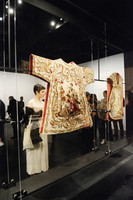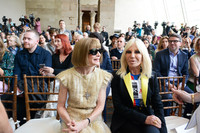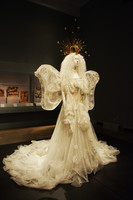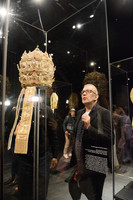





"In the Catholic imagination,” said Cardinal Dolan on May 7 at the Metropolitan Museum of Art’s press preview for the exhibit “Heavenly Bodies: Fashion and the Catholic Imagination,” “the true, the good and the beautiful are so personal, are so real that they have a name, Jesus Christ, who revealed himself as the way, the truth and the life.
“In the Catholic imagination,” the cardinal explained, “the truth, goodness and beauty of God is reflected all over the place, even in fashion. The world is shot through with His glory and His presence. That’s why I’m here. That’s why the Church is here.”
The exhibit is being presented by the Met’s Costume Institute, which annually displays fashion on a particular theme and encourages Met Gala invitees to take inspiration from that theme when choosing their attire. The gala is held each year on the first Monday in May. This year, the $25,000-a-head fund-raiser drew a broad spectrum of rich, famous and influential people, and each had a turn to show off their sartorial interpretation of the theme along the red carpet entrance to the Met.
Featured in the exhibit, the largest the Costume Institute has ever put on, are 40 masterworks from the Sistine Chapel Sacristy, including many that have never previously left the Vatican. Those works include such varied items as ornate clasps and tiaras, a collection of 12 vestments that were commissioned by the Empress of Austria for Pius VIII and took 15 women almost 16 years to complete during the mid-19th century, and the red shoes worn by John Paul II in the final years of his papacy.
Spanning 25 galleries and 16,000 square feet, the exhibit is being presented at the Met Fifth Avenue as well as at the Met Cloisters. In his opening remarks at the press preview, Met President Daniel Weiss acknowledged the commitment and travel needed to see the entire exhibit, from the Anna Wintour Costume Gallery, the Robert Lehman Wing, and the Medieval and Byzantine Art Galleries, all at the Met Fifth Avenue, to a journey uptown to The Cloisters. “In order to see this exhibit,” he said, “one has to embark on a veritable pilgrimage, which we think is great.”
Aside from the Vatican collection, the primary works on display are from modern designers such as Versace, Chanel, Saint Laurent, Gaultier, and Dolce & Gabbana. Select pieces from the plethora of Catholic art housed at the Met serve as backdrop for these modern works, creating dialogue between past and present. In his remarks at the preview, Museum curator Andrew Bolton said, “Most of the designers in the exhibition were raised Catholic, and while many of them no longer practice and their relationships to Catholicism vary considerably, most acknowledge a significant influence over their imaginations. On the surface, this influence is conveyed through their reliance on explicit Catholic imagery and symbolism.”
On a deeper level, Bolton added, “The Catholic imagination is forged by, fueled by, stories. It operates on a narrative level, which is where its power lies and where its resonance is felt.” Throughout the exhibit, the dialogue between past and present reveals itself, he said, “through a succession of stories,” as exemplified in the Lehman Wing, where “fashions inspired by…saints, angels and the Virgin Mary,” are contrasted with “garments chosen and arranged to reflect the expertly dressed and beautifully choreographed angels in the Fra Angelico painting.”
While the Met Fifth Avenue presents a dialogue related to pageantry, Bolton noted that The Cloisters “addresses the more contemplative and reverential aspects of Catholicism,” its spaces of rebuilt monasteries providing “the conceptual framework for fashions inspired by monastic orders as well as the Holy Sacraments of the Catholic Church.”
On display at the Met Fifth Avenue and the Met Cloisters until Oct. 8, “Heavenly Bodies” is a scholarly exploration of Catholicism’s relation to the world of high fashion. Asked whether there was any attempt to share that scholarship ahead of time with those invited to the Gala so it might enrich their choice of attire, Bolton said there was not, noting that some attendees and their fashion designers do extensive research while others might not do as much. “At the end of the day,” he said, “it’s a party…. I’m always really excited to see what people wear and how they take it…. Fashion on one level is about fantasy and dress up, and I think that the Gala is very much about that.”
Talking about attire that sometimes gets too much attention at the Gala versus that which might be more deserving, he said, “I think the ones that people remember are the more heavy-handed ones. It’s a pity that people don’t remember the more light-hearted ones where it’s done with such respect and such creativity.”
Asked for a reaction to Cardinal Dolan’s presence and the remarks that he gave, Bolton said, “It meant a lot to have his support and the support of the Catholic community in New York and the support of the Vatican. I love the fact that he talked about beauty and aesthetics because it can be the bridge between the believer and the nonbeliever.”